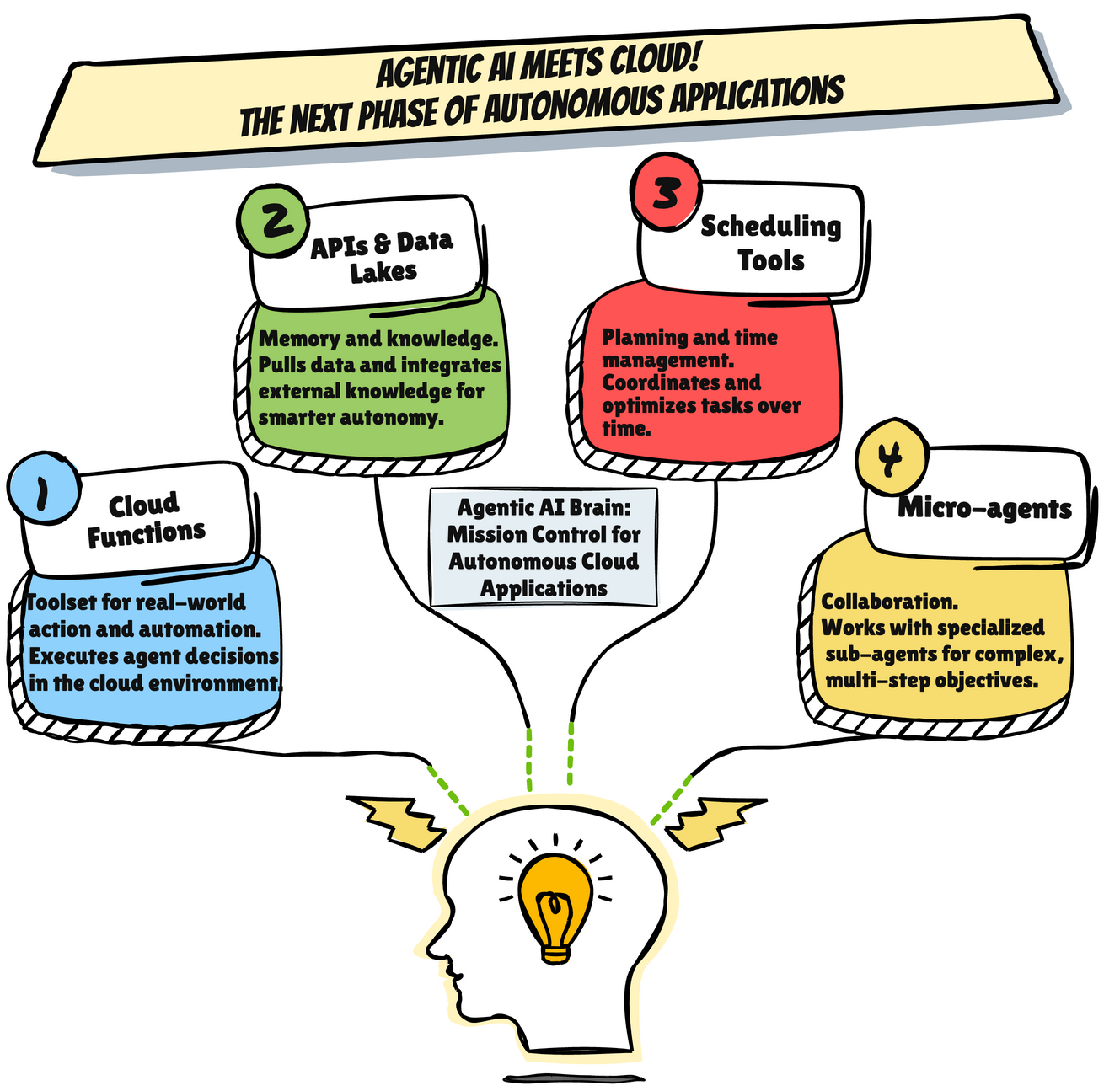No Cloud, No AI Agents: How cloud powers AI
The rise of Agentic AI represents a fundamental shift in how applications operate. No longer are intelligent systems siloed, static, or limited to following pre-baked rules. Today’s most advanced agents can make decisions, learn, adapt, plan, and act autonomously—all thanks to the immense power of the cloud. But how does this new class of Agentic AI actually harness the cloud? Let’s explore, using a “mission control” diagram to unpack the anatomy of autonomous, cloud-native intelligence.
The Mission Control Center: Agentic AI at the Core
At the heart of our diagram—and this new technological era—is the Agentic AI Brain. Think of it as mission control for autonomous cloud applications. It’s where goals are set, data is interpreted, and complex decisions are made in real time.
No Cloud, No AI Agents: Cloud Powers Agentic AI
Agentic AI Brain:
Mission control for autonomous cloud applications, orchestrating every action, memory recall, plan, and collaboration.
Everything else in the agent’s ecosystem is an extension of, or a resource for, its intelligence.
1. Cloud Functions: Empowering Real-World Action
First up on our “mission control” board are Cloud Functions. These are the agent’s toolset—a collection of ready-to-use, infinitely scalable programs that can be triggered on demand to do real work:
Action and Automation: Cloud functions translate the agent’s decisions into action—sending emails, analyzing images, or updating records.
Operating Environment: Instead of being tethered to a single device or server, these tools can execute anywhere in the cloud, scaling up or down as needed.
In essence: When an agent decides, “It’s time to act,” cloud functions are the hands that make it happen.
2. APIs & Data Lakes: Memory, Knowledge, Context
Intelligent autonomy demands more than brute force—it needs a memory and a way to learn. In our diagram, that’s what APIs & Data Lakes represent:
Knowledge Base: APIs let the agent pull in fresh information—weather reports, user profiles, real-time market data, and more.
Long-Term Memory: Data lakes serve as vast repositories where the agent’s experiences, logs, and learned models can be stored and recalled.
Integration: The ability to connect and combine disparate data sources is what gives agentic systems true context-awareness.
In practice: This is how an agent “remembers” your preferences, adapts to new info, and generates the right answer—every time.
3. Scheduling Tools: Planning and Time Management
Autonomy isn’t just about acting now, but about knowing when (and in what order) to act. Scheduling Tools are the agent’s calendar, planner, and logistician:
Optimizing Tasks: They help agents schedule jobs, set reminders, balance workloads, and avoid conflicts—across users, systems, and services.
Coordination: Tasks can be rescheduled, chained, or repeated, allowing agents to handle complex workflows over time.
For the agent: This means turning a to-do list into a robust, ever-adaptive action plan.
4. Micro-agents: Collaboration and Specialization
The last piece is all about teamwork: Micro-agents. Instead of trying to be a jack of all trades, Agentic AI can delegate:
Specialized Sub-agents: Each micro-agent can focus on a particular function—one handles data cleaning, another books appointments, another negotiates with APIs.
Collaboration: The central agent coordinates, while micro-agents execute, report back, and even work together, dynamically forming teams as challenges arise.
The result: A cloud-native hive of intelligence, where expertise and responsibility are distributed for efficiency and resilience.
Why the Cloud is the Agent’s Perfect Home?
The entire architecture radiates outward from the agentic core, empowered at every step by the cloud:
Unlimited scalability: New tools, knowledge, and agents can be added seamlessly.
Always-on connectivity: Agents can tap global resources and operate 24/7.
Modularity: Each function—tools, memory, planning, collaboration—is a plug-and-play cloud service, making development and scaling simple.
Conclusion
As Agentic AI continues its rise, its strength will come not just from smarter algorithms, but from deeper integration with the cloud. The future belongs to self-directed applications—secure, scalable, and endlessly adaptive—operating from a "mission control” at the heart of the cloud.
The image you see above isn’t just a map; it’s a blueprint for the next generation of software.

